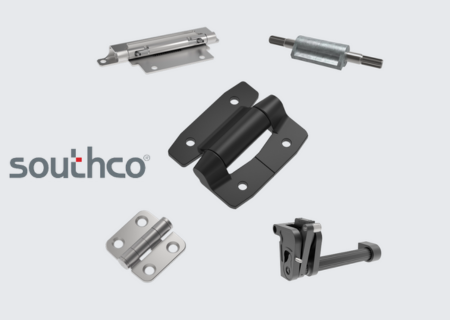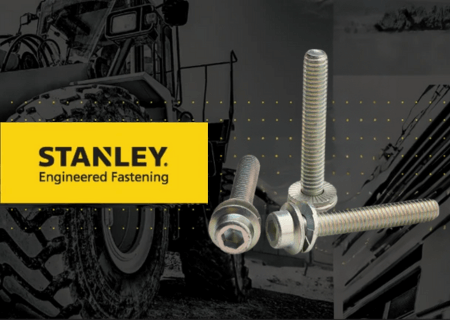Selecting the right hinge is a key aspect of designing many products. In general, hinges are used to connect a door, cover, or panel to another panel or frame, enabling movement between the two. Despite their outward simplicity, there are several factors to consider when determining the most suitable hinge for a particular application.
Hinge selection is all too often ignored until the final stages of the design process, leading to a hurried search for a hinge that meets the required operational standards. Occasionally, a product design project may be delayed if the chosen hinge does not perform as expected or fails during testing. To prevent this from happening, hinges should actually be chosen and tested at the beginning of the design process to prevent costly design revisions.
With numerous options for hinge types on the market, engineers, designers, and manufacturers face the challenge of determining the most suitable one for their needs. To make the right choice, anyone whose projects require the use of hinges must familiarize themselves with quality hinge options and their respective applications.
Southco hinges offer more than just basic swinging, providing a wide range of solutions for controlling door and panel movement that enhance functionality and performance across multiple applications. With materials ranging from lightweight plastics to heavy-duty cast stainless steel, and a wide variety of sizes and installation styles, Southco offers a complete range of function-specific and durable hinges, so we'll be referring to a choice selection of their hinges as a guide.
TYPES OF HINGES
One of the main considerations in the decision-making process for hinges is the level and mechanism of operation required by the end user to open a door or panel on equipment. There are several commonly utilized types of hinges that one can choose from to fulfill their specific application requirements.
FREE SWINGING HINGES
Free-swinging hinges like the EH Surface Mount Hinge are the most basic type of hinge. A straightforward pin or shaft serves as a pivot point. Typically, the pin or shaft is attached to one leaf, leaving the other leaf able to rotate freely. This setup enables the door to open and close smoothly, making it effortless for the user to enter the enclosed space.
Free swinging hinges do not have any extra mechanisms to assist users in shutting the door or securing the enclosure. These hinges are commonly found on kitchen cabinets due to their simplicity and affordability, making them perfect for household use. They can be made from various materials such as stainless steel and aluminum.
One basic purpose of a free-swinging hinge is to attach the pivot externally on the exterior of a door or panel. This setup ensures that the door does not interfere with the frame during opening or closing. By mounting the hinge externally, it optimizes the internal space within the enclosure.
CONCEALED HINGES
Aesthetics can influence the type of hinge selected for an application. For example, if the hinge must be hidden to improve the look of the outer cabinet door, concealed hinges like the R6 Concealed Hinge are a great option. By concealing hinges, a seamless exterior can be achieved by keeping the hardware hidden inside the casing.
Utilizing concealed hinges can also enhance security. Unauthorized entry becomes more difficult when the hinge is not easily visible as a vulnerable point of attack. Criminals will have a harder time tampering with the hinge if it is concealed. This forces would-be thieves to search for other vulnerabilities to gain access, ultimately safeguarding valuable belongings stored within the enclosure.
Nonetheless, hidden hinges may occupy important spaces within an enclosure, which can pose a challenge in certain situations. For instance, electronic enclosures have limited space due to the numerous components housed inside, making concealed hinges impractical. However, if space constraints are not a concern, users may opt for concealed hinges to discreetly conceal hardware.
REMOVABLE HINGES
Engineers can also utilize removable hinges in their end applications. Some free-swinging models can enable the detachment of hinge leaves, enabling users to fully remove the door or lid. Some may opt for a hinge that includes a spring-loaded system to make it easier to remove hinge pins while keeping the hinge components connected to the door.
One of the easiest ways to accomplish this is through the use of a lift-off hinge, such as the 96 Removable Lift-Off Hinge, which allows the door and hinge pin to be removed in a single motion. Lift-off hinges can be used in various situations. For instance, when accessing the inside of a small enclosure, removable hinges are convenient. Another scenario is when a product is delivered to the user in pieces and needs to be assembled; removable hinges can help an end user to assemble the product on their own.
DETENT HINGES
Detent hinges are designed to hold connected objects in place and are permanently attached to a door or frame. The user can open the door and have it remain in place at a predetermined angle without the use of secondary mechanical supports, such as gas struts. Certain detent hinges can be preset by the manufacturer during the design process to open doors at predetermined angles.
Detent hinges function by using a metal or an elastomer spring component that exerts force inside the hinge, providing the detent. The detent mechanism is housed and hidden inside the hinge. Detent hinges can provide hands-free access to users with a variety of positioning torques for different applications.
TORQUE HINGES
Torque hinges, also known as friction hinges, allow users to hold a positionable surface at any angle and stay in place. This differs from detent hinges, where a position and angle is pre-determined by the manufacturer. Torque hinges allow engineers to customize the forces and therefore the feel of a panel, with the aim of making the door opening/closing intuitive for the end-user.
A torque hinge offers resistance against the pivoting motion, which is useful in situations where the goal is to hold a panel in position for aesthetic considerations or safety requirements. Torque hinges add friction to the hinge’s shaft using a series of spring components that allow the hinge to accurately control the directional and rotational friction of the hinge.
The E6 Adjustable Torque Position Control Hinge demonstrates the way torque hinges can improve the end-user experience. Incorporating clutch elements into its hinge, which releases the friction in the opening direction and makes it much easier to lift, the E6 still maintains a level of friction that resists unwanted downward movement. This means that users will be able to easily open a pivotable panel while ensuring that it stays open safely, without the use of any additional hardware. Laptop screens are good examples of systems that use torque hinges - their positionable hinges allow users to keep the screen open at a desired viewing angle.
COUNTERBALANCE HINGES
There are some applications where humans may struggle to independently open a pivoting surface due to its size or weight. Hydraulic assistance might be used in this case, but there are situations where they take up too much space or cannot be trusted to safely hold very heavy or gas-volatile components. In these instances, a counterbalance hinge often proves a more effective solution. Counterbalance hinges utilize stored energy in the spring to provide the mechanical leverage needed to open a lid, panel, or door. Southco's CA Counterbalance Hinge provides a powerful spring assist that can overcome even strong weight or size challenges.
It's important to choose between compression or torsion springs depending on the available space and hinge design. Still, either spring will apply force to help with opening. For example, a heavy industrial storage panel that weighs hundreds of pounds can be safely and easily opened or closed by an end user thanks to the mechanical power of the counterbalanced hinge.
ADDITIONAL CONSIDERATIONS
Engineers, builders, and manufacturers will need to carefully consider the requirements of their industrial and project-specific needs to choose the right hinge material and size. However, there are other factors that must be taken into account when choosing the appropriate hinge.
Material choices, such as plastic or stainless steel, can affect the strength and lifespan of the hinge depending on where and how often it is used. Therefore, when making a material choice, think deeply about both the true strength required to safely open the adjustable component, and the main environments the hinge could operate. The type of adjustable component - be it a door, panel, lid, or something else - can also be a key factor in choosing what types of hinges should be ordered and used in a particular application.
For all their efficacy, depending on the project, simply browsing the most common off-the-shelf hinges may be insufficient to find the right one. A trusted supplier can offer a deep catalog of hinges that fit more specific application demands and create an experience that better serves the end user by letting engineers' design benefit from when the appropriate hinge is designed into the product earlier, rather than later, in the design process.
HTF is proud to be a trusted supplier of Southco hinges. We can help you select and order the right hinges for your applications. Contact HTF to learn more about our Southco hinge inventory and how we can supply you with the right hinges in the quantities you need, when you need them. Our team is more than happy to answer any questions you may have about hinges and our vast inventory of fasteners, hardware, inserts, and more.









